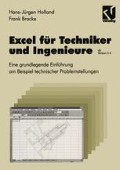Zusammenfassung
Sie kennen das Problem aus der Praxis: In einer Formel hängt das Ergebnis von mehreren Variablen ab. Um bei vorgegebenem Ergebnis den Wert einer Variablen zu ermitteln, müssen Sie die Gleichung umstellen. Das ist manchmal sehr mühsam. Unter Umständen, wenn die Variable mehrfach im Zähler und Nenner, vielleicht noch als Exponent oder Argument einer Funktion, vorkommt, ist es gar nicht möglich. Excel stellt für solche „Was-wäre-wenn“-Probleme ein Paket an Funktionen zur Verfügung.
Access this chapter
Tax calculation will be finalised at checkout
Purchases are for personal use only
Preview
Unable to display preview. Download preview PDF.
Rights and permissions
Copyright information
© 1994 Friedr. Vieweg & Sohn Verlagsgesellschaft mbH, Braunschweig/Wiesbaden
About this chapter
Cite this chapter
Holland, HJ., Bracke, F. (1994). Federoptimierung mit der „Was wäre wenn“-Analyse. In: Excel für Techniker und Ingenieure. Vieweg+Teubner Verlag, Wiesbaden. https://doi.org/10.1007/978-3-322-90611-3_10
Download citation
DOI: https://doi.org/10.1007/978-3-322-90611-3_10
Publisher Name: Vieweg+Teubner Verlag, Wiesbaden
Print ISBN: 978-3-528-05478-6
Online ISBN: 978-3-322-90611-3
eBook Packages: Springer Book Archive

